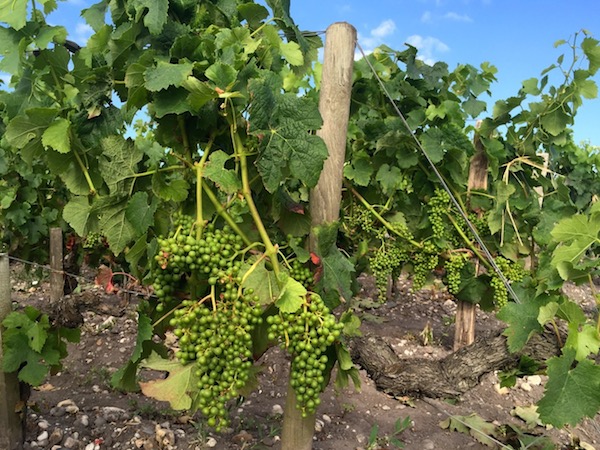'Come at the end of June', I said to my mother when we arranged for her to come and stay a while back. 'The weather should be nice then.' It has indeed been hot and sunny but we certainly weren't predicting that the temperature could reach 40 °C this afternoon. We – and the vines – are bracing ourselves for a heatwave over the next week, with the odd storm mixed in for good measure.
The prospects for the vintage, heatwave notwithstanding, are bright. As reported in Bordeaux 2015 – first hurdle overcome, Bordeaux had close-to-ideal conditions for the rapid flowering in late May and early June, which was crucial for the size and evenness of the crop; then rain after 9 June was helpful for the thirsty vines. Since the huge trade fair Vinexpo in the middle of the month, it has been dry and hot again.
Summer schedules for vineyard staff have kicked in, and many seasonal workers sensibly prefer to start the day at 6 am to avoid a scorching shift in the vineyard after lunch.
It’s also the time of year when many châteaux strip away the leaves from shading the bunches on the ‘morning sun’ side of each row of vines, to aid the ripening process. (The next two pictures show Merlot in Pauillac, with leaves intact above and leaves removed below.) The leaves are usually removed on the ‘afternoon side’ much later in the season, once the heat of summer has passed. Some even do effeuillage on both sides of the rows now, exposing the pea-sized grapes to what will undoubtedly be brutal heat. (See Cabernet Sauvignon in St-Julien, pictured below.) I know several managers who believe that early exposure to the sun helps the grapes in the long run, although I'm not entirely convinced – I mean, 40 °C? (Personally, I've postponed any leaf plucking for now.)


New plantations of baby vines also have to be watched. Most new vineyards – usually ones replacing older vines rather than entirely new sites (see EU vineyard planting rights set to change) – are planted surprisingly late in the spring or even later, as a matter of course. Irrigation is permitted only for young vines which are not in production as yet, and is usually undertaken by a team manning a huge container with water lances or hoses (as at Ch Léoville Barton, pictured below).

There are alternatives – at Ch Pavie in St-Émilion they have installed a temporary watering system for the young vines in front of the château (pictured below), while another famous estate is using individual roof tiles to protect each of the baby vines they planted in June.

After such heat, there's always the risk of summer storms. Some rain wouldn’t go amiss – just don't mention the G-word (grêle). We don't really want our experimental anti-hail nets (pictured below) to be put to the test. They are, after all, only a test.















